Scanner-accessoires and cleaning of film material
Those who want to digitalize their collection of slides or negatives will need, apart from a good film scanner, also the suitable accessoires for the safe and comfortable handling of the film material. Of course, it is possible to touch every slide or negative with bare hands in order to put them into a scanner. But specially in case of scanning some larger quantities, it repeatedely occurs that one touches the film surface by mistake and leaves some ugly finger prints on the film. In order to avoid such breakdowns, there are some practical tools of which we are going to present some on this page.
Moreover, it is recommendable to clean the films previously to the scanning, on one hand in order to achieve a better image quality, on the other hand in order to protect the scanner against dust particles. Of course there are also some cleaning utensils for the scanner itself. There are plenty of kinds of cleaning products, from the simple compressed air - spray up to the special film cleaning device.
On this page, we introduce you to some recommendable products of the range of accessoires and cleaning that make the daily life with foto material, films, digital cameras, film scanners, flat bed scanners and accessoires considerably easier. All products presented here are available in our Online-Shop. A detailed overview about the cleaning products and accessoires for digital cameras, scanners and film scanners can be found in our Online-Shop in the main class of goods Cleaning. There, you will find a large selection of cleaning cloths, anti-static brushes, cleaning brushes, cleaning sets, conpressed air sprays, compressors, special film cleaning devices and other utensils.
Anti-dust-spray, compressed air cartridges
The most important helper at the working station of everyone who has to do with film material is an anti-dust spray, as the same way the devil attracts the evil, the film material attracts dirt and dust. To put it mildly: On every kind of films there are numerous dust particles accumulating in the course of the time that, during the projection, scanning or pruning become disturbing visible. While a dust particle located on a blue sky surface can be still considered as a bird, a small particle on a face might appear as a huge pimple.
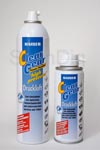
One is lucky if having a film scanner with a hardware-based dust and scratch correction; it removes the dust particles up to a certain size automatically. But such procedures also have their limitations: They do not really remove the dust but it is detected by an infrared ray and then retouched automatically. Many times, in case of some larger dust particles or hairs, such procedures fail or provide some wrong results. The remedy to that is a thorough cleaning of the film material previous to the scanning. There are numerous tools for cleaning the films before the scanning, but the most comfortable one is an air-compressed spray.
In our Filmscanner-Shop we offer an anti-dust-spray that outstands to the reason of an approximately 10 cm long plastics material cannula is put on the outlet that enables a very precise application of the air jet. Thereby, a very precise cleaning with an economical appliance of the compressed air medium is possible. Air-compressed cartridges are also available in the DIY-superstores; but most of the times, they do have a much too unprecise and much too strong air jet, so that not only the dust but the whole medium is blown away.
By purchasing an air-compressed spray it is important that the air contained in it is very clean, thus without any foreign particles. While in the case of a simple compressed-air variant for the cleaning of a PC-keyboard it does not matter wether the blown out air is extremely clean or not, in the case of cleaning the slides, the remaining dust particles contained in the compressed air can damage the surface of the film.
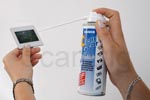
How is such a dust-off-spray in practice? In our scan-service, a bottle of compressed air is available as a matter of course at each working place where also a scanner stands. An extremely dirty slide is shortly sprayed from a distance of approximately 10 cms so that the dust particles are also removed from the corners. The precise application of the compressed air with the cannule that is only 1 mm wide is very effective and economical, so that one cartridge of compressed air is of a long service life. During the spraying of the film strips it is important to hold them properly with some cotton gloves; otherwise one easily blows the strip away from the desk. In case of slide magazines that have been kept in the cellar for decades, one achieves a considerable dust removal by simply roughly spaying between each of the frames without using the cannule.
As already said, the anti-dust-spray is an indispensable helping tool in a working place of a scanner. But there are much more modes of application of compressed air: The PC-keyboard can be effectively released from dust- and dirt particles in between the keys, the interior of a printer can be blown to cleanness, the thin dust catching slits as the ones of e.g. the hifi-amplifiers and DVD players can be blown to cleanness and much more. Shortly: A small cartridge with compressed air does not only belong to any scanner station but also generally to every household.
Professional tweezers made of steel with rounded blades
The framed 35-mm slides offer the great advantage that they can be comfortably touched by the frame, take away from an archive folder and be inserted into the scanner-film adapter. To the contrary, the 35-mm film strips only have a narrow perforation edge at which they can be touched without any problem, but it repeatedly occurs that one touches them over the perforation limit into the picture and leaves one´s fingerprints on the film. Even though one is extremely careful, those failures cannot be avoided in the course of the time.
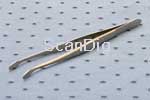
Those who have already spoiled some pictures on negative strips by this way will only hold a film strip either with cotton gloves or with some special tweezers. I intentionally use the term special tweezers, as the common tweezers for the home use do not protect the film material but damages it. The normal tweezers the way one gets them in any department store have some peaked ends so that they can hold selectively a tiny piece of paper as for example a stamp. Thereby, a small scratch on the film is generated at the contact point which can be so small that it will not be visible on the mere film. Not before visualizing a high-resolution scan one will see some scratch traces of several pixels width at the contact points which are really annoying if they are actually located on an important part of the image.

I habe to admit of having scatched some negative strips by removing them from the archive folder with some stamp tweezers like that. Some tweezers with wide rounded blade ends provide a remedy to this problem, as these blades do not take the film at a single point but the holding force is spread on a wide surface so that both blades gently press the film in between them (see adjacent image). But what is important is that the tweezer blades do not have any peaked edges but are circumferrentially rounded, as only then it is guaranteed that no scratches will arise during the holding of the film. If then the end of the tweezers have a slight angular offset from the shaft the way it is in the case of dentist instruments, one can easily catch the film without any acrobatic movements of wrist.
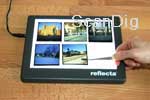
In our Film Scanner-Shop we offer such professional tweezers made of finest steel for instruments. Such tweezers are applied in our Scan-Service on a daily basis and have been proved in the course of the years. The 35-mm film strips that are kept in the archive folders, or the meduim format films that are kept in film sleeves can be comfortably and safely removed with such tweezers and be sorted on the light- or working panel. It is also very easy to remove a negative strip from the desk and insert it into the scanner or the film adapter.
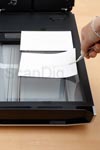
There is a further application for which the use of such tweezers is indispensable: During the sorting of any kind of films on a light panel, it is recommendable not to touch the individual images with the hands but with the tweezers, as other wise, the surface of the light panel will be covered with some ugly finger prints in the course of the time. This of course also applies for the work with a flat bed scanner. Anyone experienced that during the insertion of any kind of original material one repeatedely touches the surface by mistake; the result is having real fingerprints on each scan. This is why I also recommend also while handling a flat bed scanner to always insert the original material with the help of such tweezers on the glass plate and also to remove it with them.
Conclusion: Such tweezers with rounded blades do belong to any working station where there is either a film scanner or a flat bed scanner. Due to the reason such tweezers neither wear out or rust, it is a purchase you will make only once and under this consideration the price is quite low.
Cotton gloves and anti static gloves
During the handling of film material it repeatedely happens that one does not only touch the film at its edge but also touches up to the centre of the picture so that one leaves one's fingerprints on it. Who does not have experienced that by removing the film strip from an archive folder, the strip jams so that the only way to get it out is by touching it to pull it out? Or: During the framing of several hundred 35-mm slides, one at least fully touches once the centre of the image surface and the image can only be cleaned by laborious effort. Or: A medium format image is stucked so firmly in the film sleeve that by removing it one has to pull and shake so strongly that one inevitably leaves one's fingerprints. Or: During the insertion of a film strip into a film adapter of the scanner one touches the film layer during the fixing or the aligning.
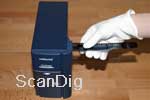
This list can be endlessly continued; also in case of a very careful handling it is not avoidable that one's fingerprint is repeatedely left on the film material. Some photographs have nearly gone mad making the effort of removing those fingerprints. But there is a very simple solution to this problem: the use of some cotton gloves. With those special cotton gloves one does not only avoid to leave some fingerprints on the material but also removes easily the slight impurities on the film.
But be careful! Cotton gloves are not always the same, as it depends on the material quality. In our film scanner shop, we offer some cotton gloves of the German manufacturer Kaiser Fototechnik specially made for the field of the photography that are proven by their thin and fine material. The advantage of this is that they feel like a sevond thin skin so that one does not lose the touch of the fingertips, as this is really important during the insertion of a film strip into a scanner or film adapter, where everything partly depends on millimetric accuracy during the adjustment. Another advantage is that coarse dust particles cannot nest in this finely woven tissue.
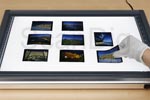
The cotton gloves are also available in DIY superstores and department stores; but they are less suitable for the handling of foto material rather then for glass tops or devices. Most of the times, such cotton gloves are thicker and made of a much more coarse cloth. A small sand particle that firmly stucks in a small notch can scratch the whole of the film strip if it is located in a part with which the film is touched.
In the course of the years, the cotton gloves have proven very well in our work and become some indispensable tools in a scanner working station. For us, the work with 35-mm film strips or medium formats without some cotton gloves is unimaginable today. After a certain using life, one should wash the gloves in the washing machine with a low temperature.
By the way, there is an even more high-order version of gloves that are the anti static-gloves of Kinetronics. Compared to the normal cotton gloves, the advantage of the anti-static cotton gloves is that they derive the static charge from negative/positive ( and of course also from other materials as PCB´s, lenses, optics). As known, the electro static charges have the effect that they magnetically attract the dust. If such charges are derived, one also prevents the dust accumulation simultaneously. The anti static gloves are also washable and have therewith a lost lasting service life.
Anti static-brushes and ministat-film cleaner
Those who work with a professional reflex camera and with changeable lenses will have always a small dust brush in their rucksack of foto equipment in order to remove rapidly the dust and fleeces from the front lense before taking a good picture. There are special anti static-brushes offered by Kinetronics that due to their fine natural and synthetic fibres do look much more like a paintbrush rather than to a brush.
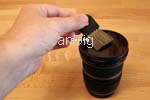
The anti static brushes are available in different sizes and with a width between 2 cm and 28 cm. The smaller models are perfectly suitable to remove the dust from a 35-mm negative strip or a 35-mm slide. The small sizes are also well suitable in order to dodge the camera lense in a quick and comfortable way. The larger models are well suitable e.g. for the cleaning of a large scanner glass top, no matter if it is the DIN A4 top of a flat bed scanner or only the glass surface of a film scanner. Also, the large anti static brushes are also perfectly suitable for the cleaning of the light panels, computer displays and TVs, simply everywhere where large glass or plastic surfaces attract the dust. It is obvious that by cleaning the glass or film surfaces with such a brush there is no risk of scratching the surface; this is why such anti-static brushes are a very safe cleaning product for he handling of glass and films.
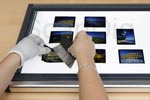
The special thing of the anti static brushes of Kinetronics is the double effect of dust and charge distance. The fine fibrers consist on electrically conductable plastic so that during the cleaning of a glass surface, not only the dust is removed but the surface is also released from electrical charges. But the nature of a neutrally charged surface does attract much less dust particles, so that afterwards it gets much slowier dirty. The electrical discharge is practically a preventive process against the coming dust.
I recommend everybody who is oftenly on the way with the camera equipment to take a small anti static brush in the rucksack. And I do not only mean the professional photographers which rucksack is replete with foto equipment but also the simply bathing tourist who wants to release his compact camera from sand and fleece particles from time to time. The fibres of the anti static brush itself can be washed with warn water and a mild cleaning soap so that such a brush will have a long service life.

A very interesting variant of the anti static brushes of Kinetronics are the MiniStats. These are two anti static brushes that are bordered in a stable steel frame. This frame is positioned or sticked on a suitable place of the desk so that one has a fixed cleaning station. The construction of it is excellent, as one only has to stick a plate of a thickness of approximately 1 mm on the desk after tearing off the protective paper; the actual steel frame with the brushes has a magnet at the bottom so that it is firmly fixed on the metal plate. Those who have a scanner with a metal case can staightly fix the Ministat with the magnet bottom on the scanner.
Such a Minitstat provides an excellent service if it is positioned right beside the scanner: Just before inserting a slide or a film strip into the scanner, one quickly pulls the slide or the film strip through those both brushes, so that the film material is released on both sides from dust and electrical charge simultaneously. This is what I call comfort, to clean the upper and the lower side of a film at once! The Kinetronics Ministat is available in different sizes: The 35mm wide variant named Ministat MS-35 is the smallest one; it is suitable for the cleaning of the 35-mm film material; a 70mm wide variant named Ministat MS-70 is available for the cleaning of medium formats. For the large formats there is the Ministat MS-100 with 10 cm wide brushes or the Ministat MS-200 withwide brushes available.
Mechanical and electrical film cleaning devices
Those who have some large amounts of films to be scanned or scan professionally on a daily level can release their films from dust, dirt and electrical charges with a cleaning device. The models of KineStat of Kinetronics are small constructions with several anti static brushes: 2 brushes are positioned below at a distance of approximately ca. 1 cm, another brush is positioned above at the level just between the lower two brushes.
Such a film cleaning device is either positioned on the scanner or it is firmly mounted/sticked on the desk beside the scanner. The KineStat has a safe grip due to its quite decent weight. In order to clean a film strip or a framed picture, it is simply pulled through the two brushes. One of course should wear some cotton gloves during this procedure in order not to touch the film surface with bare hands.
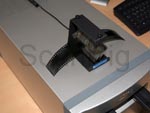
The anti static brushes clean the film from dust and dirt and derive the electrical charges. The mechanical film cleaning device is conducted with a flexible cable so that the electrical charges can flow off well. Due to the discharge of the electrical charges one avoids that these dust particles on the film surface attract.
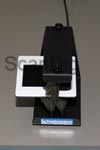
The distances between the brushes of the cleaning devices of KineStat can be changed. Thereby, the upper brush is simply lowered and/or lifted a little. By this way it is possible to get the optimal distance for one's sort of film and adapt the pressure of the brushes to the film surface. Such mechanical film cleaning devices are avaiable in different sizes, from 35mm wide brushes (KineStat KS-035) for 35-mm formats to 70mm wide brushes (KineStat KS-070) for medium format images up to 200mm wide brushes (KineStat KS-100 or KS-200) for large format originals.
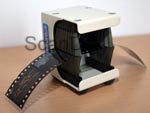
Now we come to the crème de la crème of the film cleaning devices that is the KineStat KSE-series of Kinetronics. As the mechanical cleaning devices previously described, it is a brush system with anti static brushes from the top and the bottom. But instead of 3, 4 brushes are applied whereby two are always straightly mounted above each other. The highlight of the electrical film cleaning devices is the fan between both brush pairs: it asorbs the dust particles and bonds them to an exchangeable filter at the back side of the device. Specially in the case of extremely dirty film material, it performs properly, as then the dust particles are not flying somewhere within the device and finally reappear again on the film surface, but are specifically absorbed and hold in the micro filter in front of the ventilator.
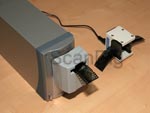
The cleaning devices of KineStat KSE that are electrically operated are of a stately weight so that they have a firm grip on the desk. Due to 4 knobs at the case bottom and also the high weight, they do not slip on the desk. But the cleaning devices of KineStat Electric KSE can be firmly mounted on the desk; therefore, the device has some small metal plates with a sticky surcafe at the bottom.
During the practice, such an electrical film cleaning device is a very comfortable thing: over a small control button at the backside of the device, the fan is switched on, pulls the individual pictures of complete film strips through the two pairs of brushes by using some cotton gloves so that afterwards, one has a well cleaned and electrically discharged film that can be well scanned. Also the electrically operated film cleaning devices of Kinetronics are available in different sizes, from 35mm brushes for 35-mm picture formats up to 200mm brushes for large format films.
Film cleaning devices, no matter if mechanical or electric, are not only suitable for film strips but also for framed 35-mm slides, framed medium format slides or large formats that are inside a passe-partout.
Wess special slide frames AHX-500K
Many times, while projecting slides with a slide projector, the popping problem occurs. The reason for that is the high heat that comes out of the projector lamp. A slide that is cool in the beginning but is rayed by the lamp for a longer period of time is heated so that the film material expands, slips within the slide frame and pops over, so that the image gets blurred in the centre or in the edge area, as the projector can only focus one level.
As a light source, the modern slide scanners do use LEDs that do not have a strong heating development so that no popping occurs during the scanning. But still there is a similar problem concerning the focusing if the slides are not evenly adjusted into the slide frame: The curved or waved slides are difficult to scan, as a film scanner, same as the slide projector, focuses on one level at a certain distance from the light source and only has a limmited depth of focus. By this way, the digitalized slides partly have a significant fuzziness in the edge areas or in the centre of the picture, depending on where the focus has sharpened.
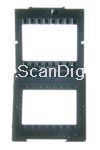
The waved or curved 35-mm slides are safely scanned by using a film adapter that firmly clamps each slide, as for examle a glass plate. But the disadvantage of a glass plate is that the glass plates have a negative effect on the image quality and partly cause some Newton-rings, thus they are not an optimal solution. A main reason for the application preference of a slide scanner to a flat bed scanner with a transparency unit is just the glass-less scanning of film material.
A safe solution for the curved, waved or rolled 35-mm slides are the WESS special slide frames AHX-500K. They are foldable slide frames with a thickness of 3 mm. The special thing of these frames are the 2 times 8 knobs, each at the top and the bottom. These knobs are exactly according to the perforation of a 35-mm film. Thus, a 35-mm slide perfectly fits into these knobs. After closing the slide frame flap, the slide is firmly fixed between both plastic plates and connot slip anymore. Of course, it is important that the slide is properly cut.
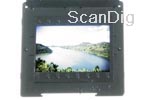
Thus, contrary to a normal slide frame, the slide is not only clamped between both plates but due to the knobs it gets a firm grip of which it cannot get out anymore. The special slide frames of WESS offer another big advantage that is that the visible image area with 35,8 x 24,4 mm covers the full 35-mm image area. Thus, with this little frame it is possible to scan a 35-mm slide without cutting a part of the image by the frame.
These special frames are of an unusual high quality: Also afer having opened and closed them for many times, the closings do not loosen. The best way to keep the WESS AHX500K slide frames is in a very normal universal cabinet.
Thus, those have a lot of strongly waved or curved slides in their archives should better frame them into those special frames previously to the scanning in order not to get any blurred image areas. Also the professionals and the astrophotographers who set a great store to capture the whole of the image should frame their slides into those WESS-special frames previously to the scanning. The slide insertion into these slide frames is effected, by the way, without any special framing tools; with some simple tweezers with rounded blades, the individual slides are comfortably set into the WESS AHX-500K slide frames.
Kinetronics SpeckGrabber
If some dirt particles that cannot be simply blown away get set on an object lense, a lense or a slide and would leave some scratches on the film by trying to remove them with a cloth, a small and handy tool named SpeckGrabber of Kinetronics is very useful.

What kind of small tool made by the American manufacturer Kinetronics is it? It is a 10 cm long pen that is hold in the hand like a ball pen. The special thing of this plastic pen is its diagonally running peak made of a special plastic material. This peak looks like a common piece of blue rubber but this material is extremely adhesive, thus it attracts the dust and the small dirt particles: With the slightest contact of the peak with a dust particle, it remains sticking on it so that it can be comfortably removed form the glass or from the film. In the case of very light dust particles, the straight contact is even not necessary, the fleece is attracted as a piece of metal by a magnet.
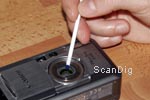
The safe handling of the SpeckGrabber requires some practice. While in the beginning, one simply tempts to press a small particle firmly to the objective lense with the flat side of the peak until it gets sticked to it, after some time, one learns to handle with the outer tip of the tool. Then, one does not press the particle against one's surface anymore but gently touches it until it gets sticked. By this way, one can remove the disturbing particles form the objective lenses, glass plates and of course films in a fast and easy way. With some practive, one can quickly go through each of the spots on an objective lense so that afterwards one can enjoy the pictures without any disturbing particles. The big advantage of the cleaning with the SpeckGrabber compared with a cleaning cloth is that one does not risk to cause some scratches on the glass or on the film with some sharply edged mini particles.
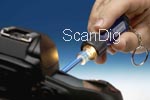
The SpeckGrabber is safely kept in a thin plastic tube, so that it can be also easily took out with the camera equipment. What is important is that it is never touched with the hands, as the grease and oil of the hands destroys the adhesive features of this special plastic. Then the only thing that helps is a thorough cleaning with soap and alcohol. By this way, I come to the conclusion that the Kinetronics SpeckGrabber SG is a very useful, small and cheap tool that repeatedely provides a good service to every photographer and people scannng films.
The basic version of the SpeckGrabber was such a success that the manufacturer Kinetronics introduced some further improved variants of the SpeckGrabber into the market: The SpeckGrabber Pro SGP works exactly as the previous model but it has a thick rubber grip so that it can be better and safer hold in the hand. The SpeckGrabber SGL Pro has a light integrated into the grip so that the object to be cleaned can be illuminated. Therewith, one can for example release one's camera objective lense or the CCD-sensor of its digital camera from dust and dirt during a foto trip even though the light conditions are disfavourable. The object to be cleaned cannot be cleaned in a better way than with an integrated mini torch.
Kinetronics anti static cloth
Those who own a film scanner will surely already have had several times the problem that the glass plate had to be cleaned thoroughly, as even though with a careful treatment it cannot be avoided to touch the glass plate with the fingers occasionally and leave some distinctive fingerprints. While the dust and fleeces can be easily removed with some simple brushes or anti static brushes, for removing the fingerprints, streaks and grease stains, a clean cloth is needed, as such dirt can be only removed by friction.
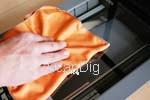
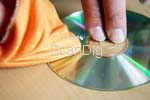
Kinetronics offers an anti static cloth ASC (Anti Static Cloth) that has been specially developed for the cleaning of the scanners glass plates and glass holders. It is a gently soft bifabric cloth sized 25 x 45 cm. The ultra soft micor fibrers remove the dust, fingerprints and grease spots gently and effectively. The conductive fibrers derive electrical charge. The advantage of this is that the glass plate is protected against further dust deposits, as, as known, the electrical charges attract dust. By the derivation of the electrical charge, one also removes one cause of the dust and fleeces at the same time, thus one also takes preventive measures against future dirt.
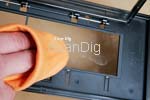
But such an anti stsatic cloth does not only clean the glass plates of the flat bed scanners and film scanners. It is also perfectly suitable in order to clean and discharge the ground glass of TVs; the same of course also applies for computer screens, no matter if tube monitors or flat screens. Another practical appliance is the cleaning of CDs and DVDs. Some CD-drivers or DVD-players are very sensitive to fingerprints and grease stains: the laser jumps and one hears/sees a jerking. With an anti static cloth, one can comfortably and safely clean a CD/DVD. Another appliance of such an anti static cloth is the cleaning of electrical PCBs.
The anti static cloth consists on a washable special tissue made of two fabrics with a different effect. As the cloth is not impregnated, it keeps its full effectiveness even after several washings. Such an anti static cloth does not only belong to a computer station but it also is a household tool of every day use that can be applied for the most different cleaning purposes either in the household as also in the office.
Kaiser Optical Glass Cleaning Paper
For the cleaning of optical glasses as for example the lenses of an objective, the use of special cleaning cloths is very recommendable, as the above described anti static cloth. Another solution for small glass surfaces is a special cleaning paper. There are very fine and thin paper sheets that are used once and then thrown away.

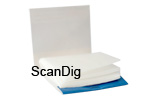
This soft cleaning paper can be either used in a dry or wet way in conjunction with some special cleaning liquids. In a dry condition it is very suitable for removing some light impurities as for example spray water. For more persistent impurities as for example fingerprints or other grease spots, one should additionally make use of some cleaning liquids in order not do damage the glass surfaces by the additional pressure that is required. There is a specific cleaning fluid for lenses, filter or glass surfaces of scanners from the cleaning specialist Kinetronics, for example the Cleaning fluid PLCD 30ml. If you use a drop of it for the front lense of an objektive and clean it with the optic paper then you will get a very clean surface without smears. Of course you need a couple of drops more for cleaning the surface of a flatbed scanner, however, you will also get that clean with the cleaning paper.
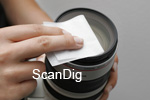
While cleaning optical glasses one should consider that the best way to remove the fixed dirt particles as dust or sand is by blowing them away or use compressed air. Once the raw dust particles have disappeared, one can then remove the remaining dust carefully with the paper. In case you use a cleaning liquid for this, please always apply it first oo the cloth and not on the glass. By this way, you avoid that the cleaning liquid uncontrolledly runs into the grooves of the objective lense, for example.
The Kaiser optical glass cleaning paper is sold in a practical booklets containing 40 sheets that, due to their small size, can be practically kept everywhere. Each sheet can be removed comfortably. Such a small package of optic paper is simply put into the rucksack together with the foto equipment or into a camera bag, so that it is always available. It is a very useful tool specially during the journeys in order to rapidly remove some dirt from the objective lense or from a filter. The Kaiser Fototechnik optical glass cleaning paper is available in our online shop in a pack of 4 units.
Kaiser air compressed cleaning device with compressor
Those who work with foto material will not be able to avoid to use compressed air for the cleaning of the original material and devices. For those who only have to clean a slide or a negative strip occasionally, a simple anti dust spray from a non-refillable cartridge as we already described at the top of this page is fully sufficient.
The compressed-air cleaning device from Kaiser is not available any more.
But if one elaborates large quantities of film material on a regular basis, the compressed air from the bottle slowly gets pretty expensive and the acquisition of a cleaning device with compressor gets worthwhile. Therewith, one protects the environment and saves money on a long term, as one then does not have the need to use those expensive compressed-air bottles. The German manufacturer Kaiser Fototechnik offers a high quality compressed-air cleaning device that is specially made for the appliance in the field of the photography and that is very handy and still affordable for the home user.
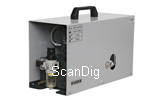
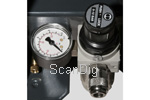
The pressure vessel that captures up to 1,5 liters can generate a maximum pressure of 6 bar. This is fully sufficient for its purpose of cleaning. The motor performance is of 135 watt and the operating noise is of the extremely quiet value of 30dB/A. The device has a manometer and a water separator. In the scope of delivery, everything needed for the operation is included: Air gun, spiral hose with quick connect, air filter and special oil for the motor including some filter necks are delivered in the box.
Concerning the data, there are comparable devices available in DIY superstores for half of the price. What is so special in the air-compression device of Kaiser? It has been specially developed for the appliance in the field of photography. This means that due to a special compressed-air filter, the blown out air is extremely clean, thus free from foreign particles. Thereby, it is guaranteed that during the blowing of the film material, no particles can cause any scratches on the film surface. Moreover, the device is so silent that it can be also operated in a quiet foto laboratory.
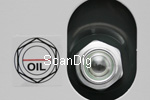
There are some simple steps to be made before the first operating session. First, the air gun has to connected with the quick connect over the spiral hose. Then, the oil that is included in the scope of delivery has to be filled with the help of the filter neck into the suction tube by switching on the compressor with the oil bottle put on. Then, the compressor automatically absorbs oil. Once the right level is reached that is readable from the oil level control at the side of the device, the device is switched off. Afterwards, the air filter is put on the suction tube. It avoids that dust particles get into the interior of the device and by this way are blown out again during the operation.
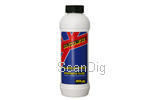

By swithching on the device, the compressor pumps air into the pressure vessel. Over the pressure control, the desired pressure of operation can be adjusted that can be read from the manometer. As soon as the pressure fell to approximately 4 bar, the compressor switches on again in order to repump air. The compressor has a pressure controller and a safety valve that opens as soon as the pressure exceeds 10 bar .
The device has to be maintained from time to time. The regular draining of the condensed water from the water separator and the pressure vessel is a part of this. This is done by opening the respective valve and/or the drain plug. In case of the regular use of the device, the oil level has also to be controlled on a weekly basis and refilled in case it is necessary. There is no need for changing the oil. Depending on the degree of pollution, the air filter should be exchanged any 6 to 12 months.

Once the pressure vessel is charged, one can start blowing. Unfortunately, the angled nozzle makes the work with foto material a little laborious. As one seldom blows air at an angle of 90°to films, for example, the air gun has to be hold diagonally. This is not a big disadvantage, but in my opinion there is no need for such a construction. A straight air jet would be simply more practical.
The adjustment of the operating pressure takes place in a very easy way over a locking screw. The pressure can be read from the manometer. As the compressor refills the pressure vessel automatically, one does not have to care of anything else during the use of the cleaning device.
In general, the compressed-air 6320 device of Kaiser is recommendable to everybody who needs some compressed air for cleaning purposes on a regular basis. Due to its extremely quiet operating noise it can be even used in the living room without disturbing the rest of the family. There is still to be mentioned that of course, the appliance of the compressed-air device is not only limited to the photography sector. Also the PC-keyboard, the printer, the HIFI, even the kitchen items can be cleaned in an easy and comfortable way with the compressed-air jet that is easy to dose.
Back to the index film scanner buy and accessories
|